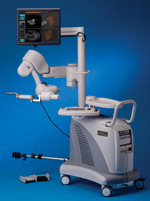Article
Imaging technology for prostate biopsy approved by FDA
Urologists can now enhance the ultrasound machines they currently have with 3-D and 4-D technology with the Artemis device, designed by Eigen (Grass Valley, CA). Artemis combines advanced imaging technology with mapping capabilities to give physicians a more complete set of information when performing prostate biopsies. It was recently cleared by FDA, and is being introduced here at the AUA annual meeting in Orlando, FL.
Urologists can now enhance the ultrasound machines they currently have with 3-D and 4-D technology with the Artemis device,designed by Eigen (Grass Valley, CA). Artemis combines advanced imaging technology with mapping capabilities to givephysicians a more complete set of information when performing prostate biopsies. It was recently cleared by FDA, and is beingintroduced here at the AUA annual meeting in Orlando, FL.

The 3-D/4-D imaging allows physicians to accurately select and biopsy a location within the boundary of the prostate, which ismapped and recorded by the Artemis so it can either be revisited or avoided later in the biopsy. The imaging program can then provide data thatcan be analyzed by the physician to determine if the prostate gland has changed if the procedure is repeated.
Eigen says this technology offers an advantage over existing 2-D imaging, which doesn't allow doctors to see the prostate inreal time or identify a location of interest for future examination.
"To be able to see and navigate to a desired location is very beneficial for prostate biopsy, as well as treatment planningand focal therapy," said E. David Crawford, MD, of the University of Colorado Health Sciences Center, Denver.




